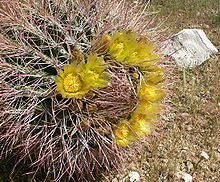Ferocactus cylindraceus
| Ferocactus cylindraceus | |
|---|---|
 |
|
| Scientific classification | |
| Kingdom: | Plantae |
| (unranked): | Angiosperms |
| (unranked): | Eudicots |
| (unranked): | Core eudicots |
| Order: | Caryophyllales |
| Family: | Cactaceae |
| Genus: | Ferocactus |
| Species: | F. cylindraceus |
| Binomial name | |
|
Ferocactus cylindraceus (Engelm.) Orcutt |
|
| Synonyms | |
|
Echinocactus viridescens var. cylindraceus Engelm. |
|
Echinocactus viridescens var. cylindraceus Engelm.
Echinocactus cylindraceus (Engelm.) Engelm.
Echinocactus acanthodes Lem. (rejected name)
Ferocactus cylindraceus is a species of barrel cactus which is known by several common names, including California barrel cactus, Desert barrel cactus, and miner's compass. It was first described by George Engelmann in 1853.
This cactus is native to the eastern Mojave Desert and western Sonoran Desert Ecoregions in: Southern California, Nevada, Arizona, and Utah in the Southwestern United States; and Baja California, and Sonora state in Northwestern Mexico.
It is found in gravelly, rocky, or sandy soils, in Creosote Bush Scrub and Joshua Tree Woodland habitats, from 60–1,500 metres (200–4,920 ft) in elevation.
Ferocactus cylindraceus is usually cylindrical or spherical, with some older specimens forming columns 2 metres (6.6 ft) in height. It is covered in long, plentiful spines, which are straight and red when new and become curved and gray as they age.
The cactus bears flowers that are maroon outside, and bright yellow inside, with red or yellow centers on the side that faces the sun. The fleshy, hollow fruits are yellow.
Having a sculptural form and picturesque qualities, this already uncommon cactus is threatened by plant collectors. It is also losing habitat to clearing for new wind farms and solar power plants in the Mojave Desert and Colorado Desert.
...
Wikipedia
